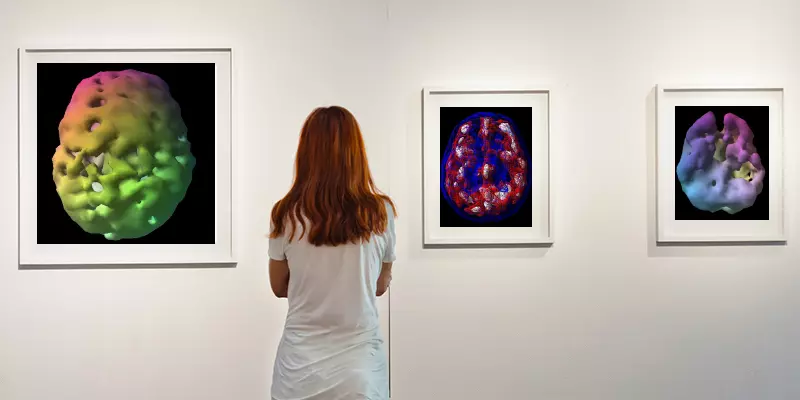
Sally was 40 years old when she sought care for mental health issues. During her clinical interview, it became clear that she had many symptoms of ADD/ADHD, including a short attention span, distractibility, disorganization, and restlessness. But she didn’t think adults could have ADD/ADHD, so she wasn’t interested in hearing about treatment. When Sally was asked if she wanted to get more information about her brain by undergoing a brain imaging test called SPECT, she was intrigued and said yes.
Sally’s brain was scanned twice—once at rest and once while she performed a concentration task. The results showed good overall brain activity when she was at rest. When she tried to concentrate, however, there was actually a decrease in activity level brain, which is the opposite of what you want to see. The decrease was especially pronounced in the prefrontal cortex (PFC), an area involved in attention and organization.
When Sally saw her scans, she burst into tears and asked, “You mean, it’s not all my fault?”
No, it wasn’t Sally’s fault that she was easily distracted and disorganized. Having ADD/ADHD is just like needing glasses. Are people who wear glasses stupid, lazy, or just not trying hard enough to see better? Of course not! Similarly, people who have ADD aren’t stupid, lazy, or not trying hard enough. They just need help to get their PFC to power up rather than powering down so they can focus better.
Sally did very well on an ADD/ADHD treatment plan that helped turn her life around. But if she had never seen her brain scan, she probably never would have gotten the help she needed.
Did you know that psychiatry is the only medical field that doesn’t look at the organ it treats? This means people like Sally often go undiagnosed or misdiagnosed for years while their symptoms worsen. Because doctors don’t look at the brain, it means they have to rely on guesswork to diagnose and treat patients with symptoms of ADD/ADHD. It doesn’t have to be this way. The SPECT brain scans that Sally had measure blood flow and activity in the brain and can take the guesswork out of psychiatry.
Here are 10 ways SPECT brain scans can help you understand and treat ADD/ADHD.
1. Brain scans show brain function.
While MRI and CT brain imaging studies show the structure of the brain, SPECT brain scans show how it functions. Basically, SPECT shows three things—healthy activity, activity that is too high, and activity that is too low. In Sally, it showed that the activity was too low while she was concentrating. It can also reveal signs of head trauma, exposure to toxins, and drug and alcohol abuse—all of which can contribute to symptoms associated with ADD/ADHD.
2. How can you know unless you look?
The health of your brain plays a major role in your ability to focus, pay attention, and be organized. There is no way to know about the health of your brain unless you look at it.
3. Brain scans offer a more accurate diagnosis.
Most psychiatric illnesses are diagnosed based on symptom clusters—the same way they have been diagnosed for over 100 years. SPECT brain imaging adds an objective, biological component to give doctors important additional information for a more accurate diagnosis. Common symptoms of ADD/ADHD include short attention span, poor impulse control, organization problems, being easily distracted, procrastination, and trouble with follow-through.
4. Brain imaging reveals there are 7 types of ADD/ADHD.
Brain imaging shows that ADD/ADHD is not a single or simple disorder. In fact, there are 7 types of brain patterns associated with the condition. Each type needs a distinctive treatment. Knowing your type, or your child’s type is the key to getting the most effective treatment. The 7 types of ADD are:
Type 1: Classic ADD
Type 2: Inattentive ADD
Type 3: Overfocused ADD
Type 4: Temporal Lobe ADD
Type 5: Limbic ADD
Type 6: Ring of Fire ADD
Type 7: Anxious ADD
5. SPECT brain scans reduce shame and stigma.
Seeing the brain helps people like Sally with ADD/ADHD understand that their lack of impulse control, inattention, or disorganization aren’t signs of weakness or a personal failure. Realizing that these symptoms are biological in nature can help people overcome feelings of guilt and shame.
6. Brain scans help break denial.
When people see their brain scan, they can no longer deny that they have ADD/ADHD. It helps them understand that their condition is real.
7. Seeing your brain scan makes you want a better brain.
When people see their SPECT brain scan results compared to healthy SPECT brain scans, they tend to develop brain envy. That’s what happened to Sally. Wanting a better brain motivated her to start taking better care of her brain, which helped minimize her symptoms.
8. Brain imaging helps to get the most effective treatment.
With a comprehensive evaluation that includes brain imaging, there is no need for guesswork. People with ADD/ADHD can get a treatment plan that is personalized for their individual needs. Sally’s treatment plan included nutritional interventions, an exercise plan, a sleep program, and targeted supplements and medication.
9. Brain scans encourage compliance.
After seeing her brain, Sally was more encouraged to follow her treatment plan, which helped decrease her symptoms of ADD/ADHD.
10. SPECT scans offer hope.
Seeing before-and-after scans of patients who have improved their brain health and overcome ADD/ADHD offers hope to people who are struggling with symptoms that are holding them back.
If you or your child are struggling with poor impulse control, lack of focus, disorganization, or a short attention span, don’t wait to seek help. About 40% of kids with ADD/ADHD symptoms and 80% of adults with symptoms don’t get the treatment they need.
At Amen Clinics, we use SPECT brain imaging as part of a comprehensive evaluation to diagnose and treat ADD/ADHD. Talk to a specialist today about how our personalized precision psychiatry approach can help you. To learn more, schedule a visit today or call 888-288-9834.






I live in the center of Ohio. Where would I go for this treatment? What otc tx can I use in the meantime?
I am 57 and have struggled all my life with ADD as well as my son and also my father. What a mess.
Is the scan covered by insurance. I have BCBS federal plan.
Comment by Lisa — May 4, 2019 @ 5:11 AM
Are there any Amen clinics in Alabama? Does Ins. Cover SPECT scan.
Comment by Cindy Harris — May 5, 2019 @ 9:48 AM
May be interested in SPECT scan.
Comment by I now know l have had depression,ADHD for a very long time. I like my Dr. But l wonder sometime if l am on the right medication. Some days it feels like it's not working like it should. If my lns. covers it, l would like to get the scan. — May 5, 2019 @ 10:01 AM
Hello Cindy, we currently have 8 locations across the U.S. and continue to expand: https://amenclinics.com/locations/.
Comment by Amen Clinics — May 6, 2019 @ 8:00 AM
Hello Lisa, thank you for reaching out. We currently have 8 locations and continue to grow: https://amenclinics.com/locations/. The closest clinic to you would be in Bannockburn, IL (https://amenclinics.com/locations/chicago/). We’d be happy to reach out to you to discuss further. Thank you!
Comment by Amen Clinics — May 6, 2019 @ 11:13 AM
I am 75 and have done a lot of studying about ADD/ADHD, it has been a very difficult life. I think I’m suffering from PTSD, and was telling counsellors that over 30 years ago before we knew what we know now. ADD/ADHD can overlap PTSD in many ways. I live in Ontario Canada. I am a single senior lady on limited means. What are the details about coming to your New York clinic, how many days do I need to stay and do you provide accommodation. Payment plans? Do I book in advance?
I am on good supplements, exercise and try to eat good food. I am constantly up and down and suicidal, low mood and not wanting to live. There seems no point to my life.
When will you be opening a clinic here in Canada, preferably Toronto?
Warmly Valerie
Comment by Valerie palmer — May 10, 2019 @ 12:33 PM
How does spect scan help with autism (lower end of spectrum) and what are best ways to treat it
Comment by Gerard — May 15, 2019 @ 3:11 AM
I am interested in having a SPECT scan. How much does it cost?does insurance cover any of it? I am a 44-year-old teacher and want to understand what’s going on in my brain in order to work towards healing and/or most positive outcome.
Comment by Melissa — May 15, 2019 @ 4:02 AM
Are there any types of food you can eat for the disorder my son has ADD/Bipolar schizophrenia some days he ok then mad and angry right now he’s taking zyprexa. A concerned mother.
Comment by Djuan — May 15, 2019 @ 6:56 AM
Hi, i took your test & im type 8 and i need help and answers to know what can i do to better myself.Because i want to go back to school to better myself and have a better life.But i feel so dum that im scread of trying school again im 56 . So can you please help me.
THANK’S
Comment by Rose — May 15, 2019 @ 2:12 PM
Does insurance cover your program?
Comment by Audrey — May 25, 2019 @ 4:54 AM
Hello Audrey, unfortunately, we don’t accept insurance. We are a fee-for-service mental health clinic, but we do assist our patients in collecting reimbursement and offer financing options through Care Credit as well.
Comment by Amen Clinics — May 29, 2019 @ 7:24 AM
What are the risks of radiation, etc. from the scans?
Comment by Holly — June 13, 2019 @ 6:47 PM
Hello Holly,
The average radiation exposure for one SPECT scan is 0.7 rem. Two of our SPECT scans are roughly equivalent to, or a bit less than, one CT scan of the abdomen or pelvis (about 0.7, depending on the protocol). This amount of exposure is well below the cut-off level (10.0 rem) for any known potential or observable health risks.
We have more information in our FAQs on our website: https://amenclinics.com/faq/.
Comment by Amen Clinics — June 17, 2019 @ 3:22 PM
I am also look8ng for your clinic in or near Canada, preferably Toronto.
J.
Comment by I am also looking for your clinic in Toronto. — June 19, 2019 @ 3:40 AM
Great read!! Thanks for sharing such a great blog.
Comment by Mark Hamlin — October 31, 2022 @ 5:01 AM
It would be great if the people suffering with biological brain disorders, could afford a SPECT scan or have their insurances cover it. I am wondering why major hospitals across the country has not adapted this form of diagnostic testing.
Comment by marie mout — October 26, 2023 @ 8:35 AM